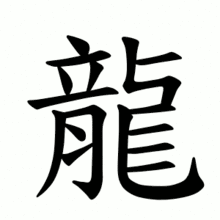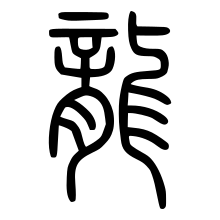Radical 212
Radical 212, 龍, 龙, or 竜 meaning "dragon", is one of the two of the 214 Kangxi radicals that are composed of 16 strokes. The character arose as a stylized drawing of a Chinese dragon[1], and refers to a version of the dragon in each East Asian culture:
- Chinese dragon, Lóng in Chinese
- Japanese dragon, Ryū or Tatsu in Japanese
- Korean dragon, Ryong or Yong in Korean
- Vietnamese dragon, Rồng in Vietnamese
| 龍 | ||
|---|---|---|
| ||
| 龍 (U+9F8D) "dragon" | ||
| Pinyin: | lóng | |
| Bopomofo: | ㄌㄨㄥˊ | |
| Wade–Giles: | lung2 | |
| Cantonese Yale: | lung4 | |
| Jyutping: | lung4 | |
| Kana: | リョー ・リュー ryō, ryū たつ tatsu | |
| Kanji: | 竜 ryū | |
| Hangul: | 용 yong | |
| Sino-Korean: | 룡 ryong | |
| Stroke order animation | ||
 | ||

It may also refer to the Dragon as it appears in the Chinese zodiac. It is used as the symbol for Tatsu, a roller coaster at Six Flags Magic Mountain, in California.
In the Kangxi Dictionary 14 characters (out of 40,000) are under this radical.
It occurs as a phonetic complement in some fairly common Chinese characters, for example 聾 = "deaf", which is composed of 龍 "dragon" and the "ear" 耳 radical, "a word with meaning related to ears and pronounced similarly to 龍": "dragon gives sound, ear gives meaning".
Characters with Radical 212
| strokes | character |
|---|---|
| without additional strokes | 龍 |
| 2 additional strokes | 龎 |
| 3 additional strokes | 龏 龐 |
| 4 additional strokes | 龑 |
| 5 additional strokes | 龒 |
| 6 additional strokes | 龓 龔 龕 |
| 16 additional strokes | 龖 |
| 17 additional strokes | 龗 |
| 32 additional strokes | 龘 |
| 48 additional strokes | 𪚥 |
Literature
- Fazzioli, Edoardo (1987). Chinese calligraphy : from pictograph to ideogram : the history of 214 essential Chinese/Japanese characters. calligraphy by Rebecca Hon Ko. New York: Abbeville Press. ISBN 0-89659-774-1.
- Leyi Li: “Tracing the Roots of Chinese Characters: 500 Cases”. Beijing 1993, ISBN 978-7-5619-0204-2
References
- 龍: bottom left: jaws (open downwards); top left: back of head: right side: body and legs and tail
External links
| Look up 龍 in Wiktionary, the free dictionary. |
| Wikimedia Commons has media related to Radical 212. |